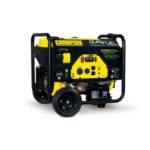Getting a generator for your home is one of the best ideas, especially in a power outage. Generators help you with all kinds of electricity requirements throughout the day.
You can have a small generator for your home, RV, or worksite to never face electric problems.
You should, however, connect your generator to your home’s breaker box or transfer the switch correctly. You don’t want it to trip when running in case of a power outage. Also, check the wattage requirement of your home before buying a generator.
Connecting a generator to your house is a process that requires some knowledge and can be tricky for someone who doesn’t operate electrical panels regularly.
This post will look at the steps involved in properly connecting your generator.
What is the Purpose of a Transfer Switch?
Many people confuse generator transfer switches with automatic transfer switches (ATS). They are not the same. A generator transfer switch is a device that allows you to connect a generator to your home’s main panel so you can have electricity when the utility power goes out.
The purpose of an Automatic Transfer Switch, or ATS, is to ensure the continuity of critical loads during a power failure. Although other devices can provide similar functionality, including load-shedding panels and uninterruptible power supply equipment, these alternatives do not necessarily have the full capabilities and safety features of automatic transfer switches.
An ATS automatically transfers power from its primary source to a backup generator in the event of a primary power failure, outage, or temporary service interruption.
Automatic transfer switches are typically used in hospitals, telecoms, data centers, and emergencies.
Related: Best Portable Generators
Why a Generator Needs a Transfer Switch?
Skipping the transfer switch and connecting your portable generator directly to your electrical service panel is tempting. It saves time, money, and installation hassles.
Connecting your portable generator directly to your home’s electrical service panel is tempting but dangerous. Please don’t do it! You could be risking fire and killing your electrical system and all your electronics.
What Are the Three Options for Connecting a Generator to Your House?
When you install a generator, there are three primary options for powering it. Use a transfer switch or an interlock kit, or attach a generator directly to the main breaker panel. A transfer switch is the best option as it allows for seamless and automatic switching between the utility and generator sources.
However, a transfer switch must be purchased separately as it is not included with most generators. An interlock kit connects to a standard contactor and provides manual switching between sources. The kit is less expensive than a transfer switch.
Use an Interlock Kit
You need an interlock kit or transfer switch if you have a generator to provide backup power. Both devices allow your generator system to be turned on and off automatically using household-load circuits. Although kits are less expensive than switches, they aren’t as effective.
Many people think they must have a transfer switch to use a portable generator. Sometimes they confuse the interlock kit with the transfer switch.
A transfer switch is required to control or de-power an electric system when connected to a generator. It senses power from the utility and diverts it to the generator.
An interlock kit is a small piece of equipment that will close off your power source if your generator fails or there is excess gas in the house.
We should warn you that connecting a generator to your home without a transfer switch can lead to dangerous situations.
Conclusion
Generators are invaluable to have in times of power outages. They can give your home peace of mind regarding safety, warm food, and security.
However, installing a generator in your household’s electrical system can be dangerous even if you follow all the right steps during installation.
Unless you have a rudimentary understanding of electrical work, installing a generator to your home’s wiring can be risky.




